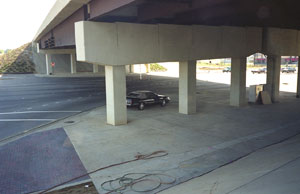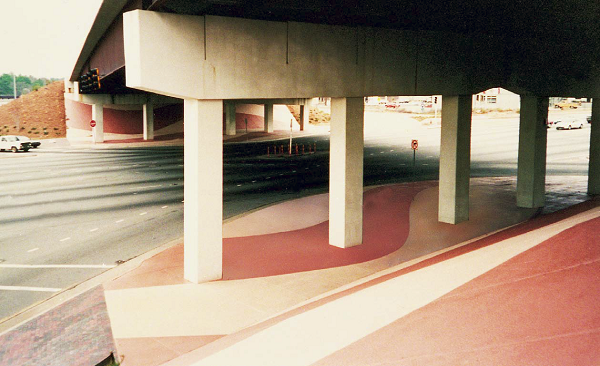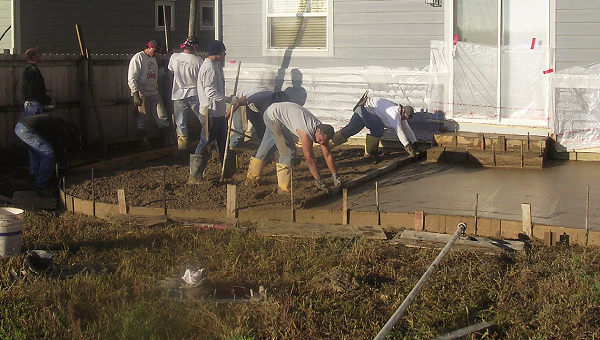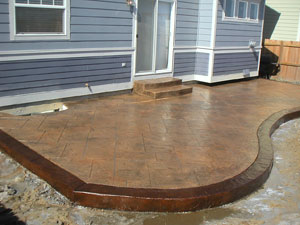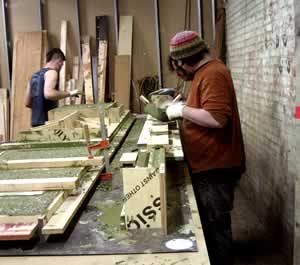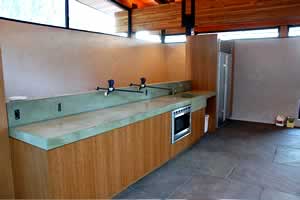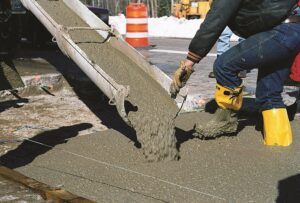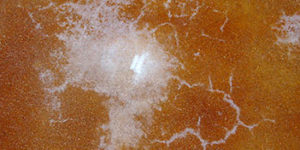Concrete Decor asked artisans around the country about their experiences installing projects during cold weather. They faced freezing temperatures, snowy weather, and even challenges indoors during cold spells. Each artisan found his own solution for handling work during the winter months.
Saved by a sealer: I-85 underpass, Columbus, Ga.
When PermaCrete/Quality Systems Inc. was called upon to resurface a concrete area under an Interstate 85 exit in Columbus, Ga., they had no idea what Mother Nature had in store.
“The sudden drop in temperature and the snowstorm came as a big surprise, but we just had to live with it,” says George Henderson, president and CEO of the company.
The November weather brought temperatures that dipped as low as 19 degrees Fahrenheit. Add blowing snow on the last day while installing the final sealer coat, and you’ve got quite a challenge.
“Set times, dry times and cure times were all greatly extended by the temperatures as well as the precipitation,” Henderson says. “We even tried to speed up some of the processes by using big fans and heat blowers.
“Fortunately back then, we also had xylene-based sealers in addition to water-based sealers on the job site, and since xylene is impervious to temperatures below freezing, we used the xylene sealers and it worked out fine. As soon as the xylene evaporated from the applied sealer within 20 to 30 minutes, the sealer coat was set and unaffected by the weather.”
Henderson quickly added that it was still a difficult job even with the increased set times.
The cold weather didn’t have too much of a long-term effect on the concrete. Henderson says it looks virtually the same today as when it was completed eight years ago.
Shocked by snow: Garage floor, Aspen, Colo.
Sean Shiers, owner of Global Garage Flooring & Design in Denver, knows that you have to be prepared for cold weather if you plan on doing work during the winter months.
However, he and business partner David Schneider were still caught off-guard when repairing and resurfacing a garage floor in Aspen, Colo., during the winter of 2007.
“The temperature was zero degrees with a small amount of snow in the air,” he says. “We were prepared for the cold weather but not the snow.”
To keep the snow out of the garage, Shiers and his crew had to construct a small cover over the garage’s opening. Once that was complete, Shiers said the only other thing the weather affected was the length of the cure time. The temperatures added about 25 minutes to each step.
Because of Colorado’s harsh winters, Shiers uses Flexmar’s Polyaspartic Polyurea. “It’s the only product on the market that will cure at low temperatures and provide the chemical and abrasion resistance needed for the garage floor,” he says.
Thanks to the product’s fast cure time, Shiers says the residents were able to drive their cars into the garage the next day.
Watching for warmth: Patio, Frederick, Colo.
For Rob Sonders, owner of Sonders Enterprises, planning is key to decorative concrete projects during the Colorado winters. By watching weather forecasts and waiting for a warm front, Sonders was able to successfully time the creation of an exterior concrete patio in December 2005.
“We picked a warm, sunny day,” Sonders says. Warm for a Colorado winter, that is. “Pour day was about 35 to 40 degrees. I remember being cold that morning.”
Despite the warmer temperatures, Sonders still faced common winter challenges. “One of the challenges once we excavate is keeping the frost out of the ground,” he says. “(To avoid frost) we excavate and replace with dry road base or recycled concrete material. Then we keep the area dry with two layers of plastic until the appropriate pour day arrives.”
For this particular project, Sonders utilized 4,000-psi concrete and nonchloride accelerator. He also placed blankets on the evening to help protect the concrete from chilly nights.
“There’s a little bit of a challenge,” he says. “There’s a lot of work to be done even after hours. We come back at 9 or 10 at night just to make sure the concrete is hard enough to put our blankets down.”
This process was done for four nights, with power washing occurring on the fifth day after it was set. Temperatures were still crucial.
“We’ve got to make sure that fifth day is above freezing,” he says. “We like to be above 40 degrees. That’s really our magic temperature.”
Freezing freight: Countertop, Ancramdale, N.Y.
Although Mike Karmody and his crew at Stone Soup Concrete cast most of their projects in their Florence, Mass., shop, they still face wintertime challenges.
Transporting the 3-inch-thick countertop and backsplash pictured here to its final location during February was no small task. “The site conditions were cold and quite windy,” says Karmody, who owns the business along with Mike Paulsen.
However, the crew lucked out and there was no precipitation during installation. Temperatures were above the freezing mark inside the house.
When Karmody transports a project to its destination, cold temperatures are a behavior-changing factor. This is partially because of the safety of those in the vehicle, and partially because of the product itself.
“If it’s below freezing we have to make sure there’s no moisture still in the sealer,” he says. “In order to transport the piece we load it at the last possible moment into the truck. Sometimes we put a heater in the truck.”
The cold temperatures actually helped Karmody with this project. The truck had to drive through a field, and the ground was hard enough to allow workers to get closer to the house. If it had been warmer, the field would have been a muddy mess, he says.
“The cold was a factor, but we got it in. Nobody slipped, nobody hurt themselves, and that’s what is important.”



